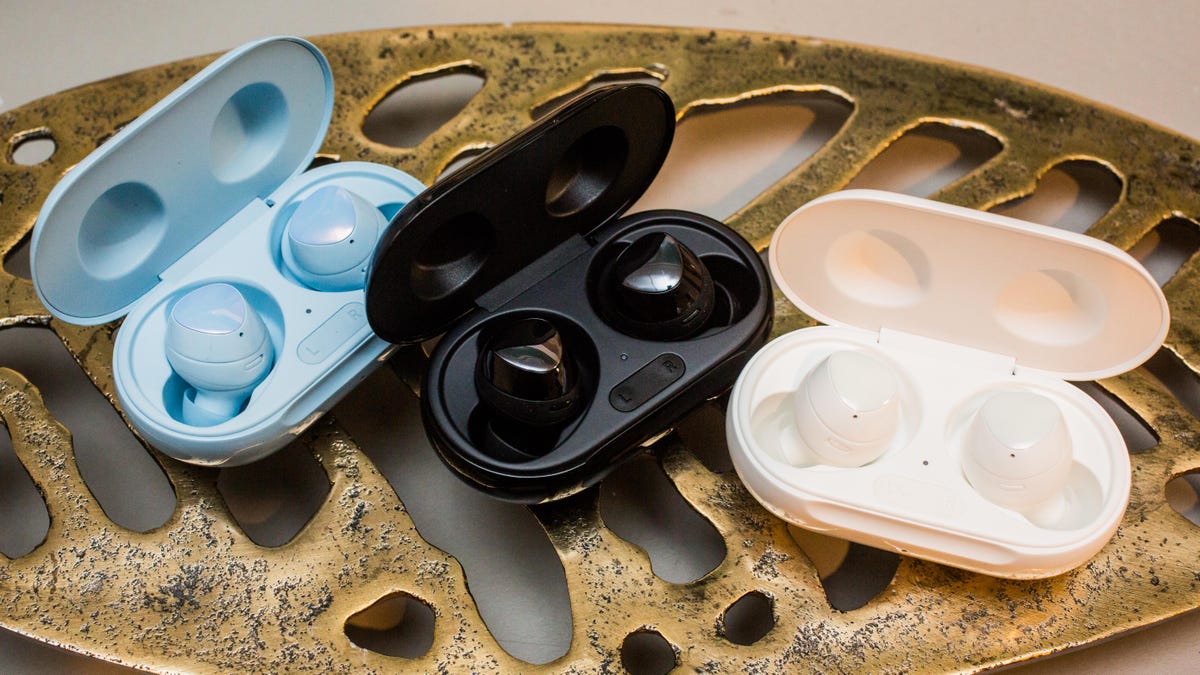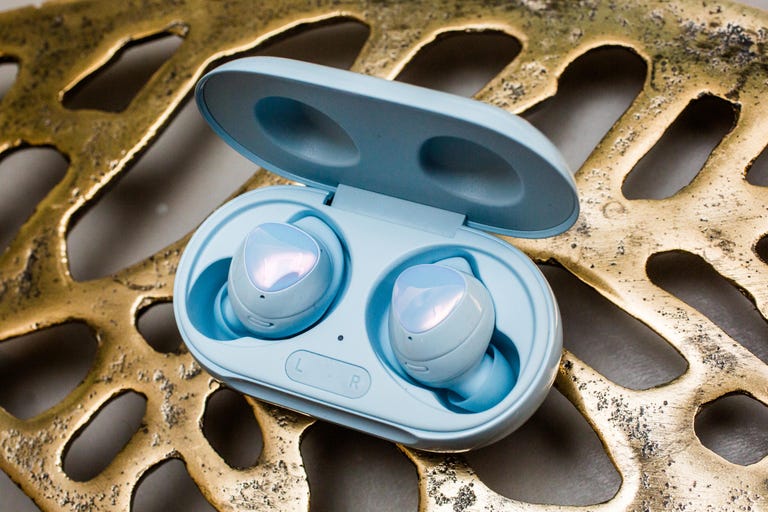 Why You Can Trust CNET
Why You Can Trust CNET Samsung Galaxy Buds Plus review: AirPods competitor ramps up the performance
The Galaxy Buds Plus may look the same as their predecessors, but they're significantly improved.
The Galaxy Buds Plus is available in 3 colors.
Editors' note, Aug. 17, 2021: With the arrival of the new Galaxy Buds 2, Samsung has discontinued the Galaxy Buds Plus. Like most discontinued electronics, you'll probably be able to buy them for a while at a nicely discounted price. Our original review follows below. Read our Galaxy Buds 2 review here.
Like
- Improved sound, with dual drivers that deliver better bass performance
- Boosted battery life (11 hours)
- Significantly better for making calls
- New iOS app for Apple users
- USB-C and wireless charging
Don't like
- Same design as standard Galaxy Buds
- Priced higher than the previous model
- No active noise canceling
- Only IPX2 water-resistance
When I put together a list of best true wireless earbuds of 2019 in a YouTube video, I took some heat from fans of Samsung's Galaxy Buds for not including them in my roundup. I liked the Galaxy Buds, I said, but I thought they were lacking in a couple of areas: They sounded decent for their price -- but not great -- and they just weren't good for making calls in noisier environments because callers complained about hearing too much background noise.
But now Samsung gets a do-over in the form of the Galaxy Buds Plus, which have launched alongside the company's new Galaxy S20 and Galaxy Z Flip smartphones. The new Buds Plus look essentially the same as the originals, but they have some improvements on the inside that boost performance significantly: Their battery life is rated at 11 hours for music playback (up from six), and they pack improved drivers for better sound and an additional microphone in each bud to help with external noise reduction while making calls.
At $150 (£159, AU$299), they cost $20 more than the Galaxy Buds. And they're not bundled with Samsung's new phones, but the $150 preorder credit with the Galaxy S20 Plus and S20 Ultra (when ordered via Samsung's site) effectively knocks the price down to free. Alas, while they feature the same noise-isolating design, they don't offer active noise cancellation like Apple's AirPods Pro do.
Available in three color options, black, light blue and white, the Galaxy Buds Plus have the same dimensions as their predecessors and look nearly identical. However, they weigh 6.3 grams (0.2 ounce), or 0.7 gram more than the Buds. That's because they have a larger battery and two-way drivers, with a woofer and tweeter, as opposed to a single driver. The battery case, which charges via USB-C and wirelessly with any Qi-compatible charging pad, is also equipped with a larger battery -- a three-minute charge in the case gives you one hour of juice. And yes, all of those new Samsung phones have the Wireless PowerShare feature, so you can top off your Galaxy Buds Plus just by resting the case on the phone's backside.
The other noteworthy changes are multidevice pairing -- an often overlooked feature that many people appreciate -- and an iOS app geared to make the Galaxy Buds Plus more friendly to iPhone owners. At launch, the app garnered many negative reviews from current Galaxy Buds owners because it doesn't appear to be compatible with the original Galaxy Buds. But I thought the app was fine.
The app gives iOS users access to firmware upgrades, EQ settings for tweaking the buds' sound and "ambient sound" settings that allow you to adjust the buds' transparency levels (off, medium or high), letting sound in from the outside world into the buds. In the app, you can also opt to have ambient sound on when making calls. That allows you to hear your voice in the earbuds while talking. (This is sometimes referred to as Sidetone.)
Android users use Samsung's Galaxy Wearable app and get a few small features not available to iOS users, the biggest of which are one-touch Spotify access from the buds themselves and a gaming mode to "minimize audio delay for vivid, synchronized gaming sound." I used the buds with an iPhone 11 Pro and a Galaxy S9 Plus .
The Galaxy Buds Plus keep the same touch controls as the Buds. They work well and are quite responsive, although my double-taps to advance a track forward sometimes turned into triple taps that ended up restarting the track I was listening to (you triple-tap to skip back one track). In the app, you get some options for customizing the touch controls, including adjusting volume with a long press. There's even an "experimental" setting that enables you to use the edge of the buds for volume and the center for other controls.
The Galaxy Buds fit my ears well, and the Galaxy Buds Plus felt very similar in my ears. These are pretty compact buds (they stick out from your ears a little, similar to Jabra's Elite 75t) and should fit most ears well. The only issue I had was with the ear tips. With these types of noise-isolating earphones it's crucial to get a tight seal to get optimal sound quality. I got a pretty good seal with the largest of the included tips, but things improved when I switched to my own ear tips. (One of the advantages of reviewing a lot of headphones is that I have a lot of ear tips lying around.) The ones I used were rounder and little wider than the included tips, which should work fine for many people's ears. The Samsung tips -- three sizes are included -- are a little more convex.
I opted to use the middle-size wing tip (three sizes are included) and got a nice secure fit. Although these have only IPX2 water-resistance, they are sweat-resistant (to a degree) and can be used at the gym and for running. That said, competing models like the Jabra Elite 75t (IPX5) offer higher water-resistance ratings and some are fully waterproof.
I was impressed with the sound. It's detailed and smooth, with deep, well-defined bass. The sound is richer and more spacious than that of the original Galaxy Buds. Well-respected Austrian audio company AKG, which Samsung acquired when it bought Harman, is behind the audio. While the original Buds were also "tuned" by AKG, these are a nice upgrade over the originals -- and right there with what you get with the Jabra Elite 75t, if not even a touch better. Like many headphones these days, there is a little presence boost to help make your music sound more detailed and exciting, but which leads to some faint sibilance in the highs. You can toggle between a few EQ settings -- Soft, Bass Boost, Dynamic, Clear and Treble Boost -- but I stuck mostly with the Normal EQ setting, which seemed the most balanced.
The buds look the same as their predecessors but weigh slightly more, thanks to new components on the inside.
Aside from the better battery life, the other performance enhancement you'll most appreciate is the call quality. The added external microphone for better noise reduction during calls helps correct the earphones' biggest weakness. The Galaxy Buds may not work quite as well as the AirPods Pro or Anker Liberty Air 2 for making calls, but they're significantly improved in this area from the original Galaxy Buds. In our test calls from the New York streets, external noise from traffic was effectively reduced and my voice could be heard clearly.
I'll also add that my wireless connection remained rock-solid during my two days of testing. New York can be notoriously difficult on true wireless earbuds with interference issues, but I didn't experience any dropouts or glitches. I also didn't notice any problem with audio syncing when using various video streaming apps (including YouTube, Netflix and DisneyPlus).
Ultimately, I don't think these will slow the sales of AirPods, but the Galaxy Buds have only become a better option for Android users and may even earn some fans who use iOS devices. Hopefully, they'll come down in price a bit -- I would have liked to have seen the original Galaxy Buds go to $99 and have these priced at $129. But if you do go the preorder route for your new Galaxy phone and can effectively get these for "free," you won't be disappointed.



